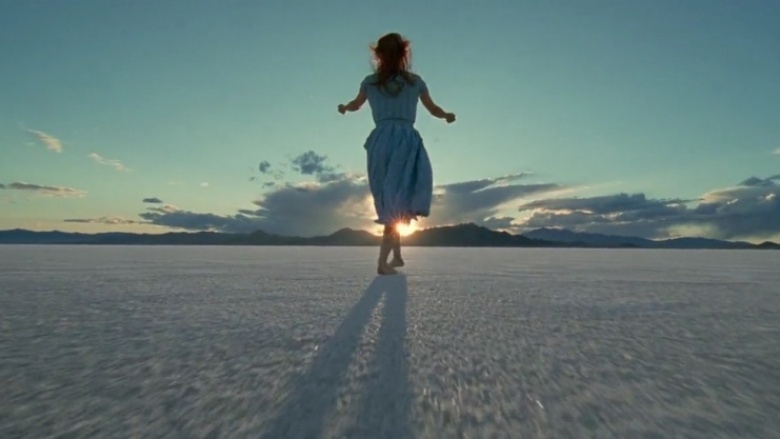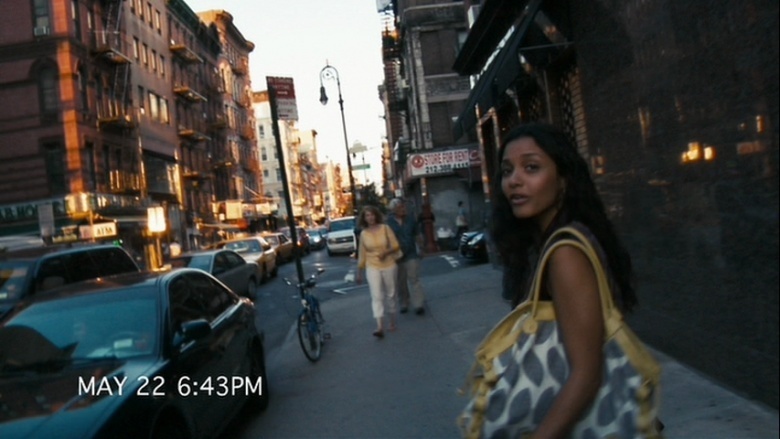Movies That Made Audiences Run Away
Sometimes a cinematic adventure dishes out more than we can handle. Too gross. Too creepy. Too sad...or just bad. From crazy camera work to low-frequency sound waves, there are plenty of triggers that send audiences heading to the exits.
The Walk (2015)
Even seasoned film critics and industry insiders felt the dizzying effects of French daredevil Philippe Petit (Joseph Gordon-Levitt) walking a tightrope between Manhattan's Twin Towers, more than 1,300 feet above the pavement. "I had to look away a couple of times because of the sensation of the height," said Denise Widman, board director of the Boston Jewish Film festival, to the New York Post. "I felt a little bit queasy. I felt nervous. It was a tingling sensation and some anxiety." Others reportedly left the theater to vomit, and many reported symptoms of vertigo.
The 3D biopic recreates the notorious 1974 stunt in ways that past mediums, including a memoir and a documentary, could not. All previous footage of Petit's heartstopping stroll between the skyscrapers, which he completed eight times over 45 minutes without a safety net or harness, was captured from the ground or the buildings. "The thing that neither the book nor the documentary could do was actually put the audience up on the wire with Philippe," Director Robert Zemeckis told Vanity Fair. "We did. And that is what movies are all about." That and, apparently, barfing.
Freaks (1932)
Director Tod Browning's pre-code horror film about a circus proved so shocking that its original copies were pulled from theaters and destroyed, along with Browning's career. In the movie, a gorgeous trapeze artist plans to marry and then murder the leader of the side-show performers to gain his inheritance. The plot pits the "normal" members of the circus against the "freaks." Browning cast real circus folk with abnormalities to play the side-show performers.
Viewers were supposed to learn that one's looks do not equate to one's morality, but moviegoers didn't see it that way. "It is impossible for the normal man or woman to sympathize with the aspiring midget," said a contemporary review in Variety. The Hollywood Reporter called it "an outrageous onslaught upon the feelings, the senses, the brains and the stomachs of an audience." Mass walkouts ensued. The UK banned the film, and one woman threatened to sue MGM, claiming the movie made her miscarry, according to The Guardian.
It's hard to comprehend that level of loathing among today's audiences. American Horror Story: Freak Show on FX stars characters just like Browning's, and it was nominated for 19 Emmys and took home five in 2015.
127 Hours (2010)
In 2003, outdoorsman Aron Ralston was trapped in a slot canyon in Utah, his right arm pinned by a boulder, for 127 hours. To escape, he sawed off his arm with a dull pocketknife. True story. In 2010, Director Danny Boyle released a movie about it, starring James Franco as Ralston, but when viewers arrived at that pivotal scene, many couldn't hack it. Movieline.com compiled reports of fainting, vomiting, and seizures at film festivals and screenings across the country.
"It's meant to be an intense, personal, immersive experience. This isn't a horror film," Franco told Vulture. "...you're spending the entire movie with one guy. You, as the audience, are going through it with Aron. When you watch the footage of him talking into that video camera to his family, you feel like he's talking directly to you. And when he cuts off his arm, maybe it feels like it's happening to you."
Despite the suffering of moviegoers, the film was nominated for six Academy Awards, including best picture and best actor.
Irréversible (2002)
Don't be ashamed if this controversial French film makes you want to curl up in the fetal position. Critic Roger Ebert gave the movie three stars but called it "so violent and cruel that most people will find it unwatchable." He was right. Viewers walked out at even the most highfalutin film festivals, but it wasn't just the brutality that overwhelmed audiences. There was also a scientific explanation for their abhorrence. Director Gaspar Noé added low-frequency background noise to the soundtrack of his revenge thriller. Though such extreme bass waves are inaudible to humans, infrasound "has been demonstrated to induce anxiety, extreme sorrow, heart palpitations and shivering," the BBC reported in 2013. "Naturally-occurring infrasound has been associated with areas of 'supernatural activity' as well as being produced prior to natural disasters such as storms and earthquakes."
"Our response to certain kinds of noise is something so profound in us that we can't switch it off," science writer Philip Ball told the BBC. "Film composers know that and use it to shortcut the logical part of our brain and get straight to the emotional centres."
The Paranormal Activity franchise and other horror movies have allegedly used this tactic as well, so the next time you're watching a movie between your fingers, don't fault your courage. Blame the fear frequency.
Tree of Life (2011)
Film scholars called this movie a masterpiece, while the man on the street asked for his money back. Terrence Malick's experimental drama explores the creation of the world, the meaning of life, the polarizing tug between science and religion, and the complexities of a family's bond as experienced by a middle-aged man's childhood memories of 1950s Texas. That's a long sentence about an ambitious film. Go ahead, let it digest. Perhaps it was too much for the average date night, because folks left the movie in droves. They weren't scared or grossed out. They just didn't like it.
Disputes about refunds arose, and theaters scrambled to make clear their policies. The Avon Theater in Connecticut posted a sign urging customers to "read up on the film before choosing to see it" because it was not issuing refunds, reported The New York Times. Other cinemas agreed to reimbursements for those who left within 30 minutes.
Cloverfield (2008)
If the found-footage horror film Cloverfieldmakes you lose your lunch, fear not, you're not alone. Because so many people got sick during screenings, some cinemas began posting warning signs, and WebMD wrote an article about it: "While motion sickness is usually caused by plane, boat, or car movement, bumpy camerawork could definitely do it, too," said Dr. Michael W. Smith. In the movie, six Manhattan millennials are attending a party when a gigantic monster attacks the city. Their experience is documented on a personal video camera later recovered by the U.S. Department of Defense. The footage was so jerky that much popcorn was regurgitated in cinema seats, bathrooms, and the expanse of flooring between the seats and the bathrooms.
According to WebMD, "Motion sickness occurs when the brain receives conflicting messages from the inner ear, the eyes, and other parts of the body. While watching Cloverfield, viewers were sitting still in their seats, so there inner ear was telling their body they were motionless. But the bumpy camera movements—and their eyes—misled them into thinking they were moving erratically." Similar side effects occurred during screenings of The Blair Witch Project in 1998.
Fortunately, Cloverfield's first quasi-spinoff, the 2016 hit 10 Cloverfield Lane, dispensed with the nausea-inducing camera work, opting for good old-fashioned cinematography instead.
A Clockwork Orange (1971)
Stanley Kubrick's adaptation of Anthony Burgess' chilling British dystopia A Clockwork Orange was instantly considered brilliant, dangerous, and also a little maddening. Actor Malcolm McDowell said he saw people "walking out of screenings in droves." The slow pace turned some people off ("nobody spoke for the first 45 minutes," according to McDowell), while others were outraged by the ultra-violent content and scared that it would inspire a generation of savages. Although Kubrick stood by the movie and denied that was his intention, a rash of copycat crimes in one town in England convinced the studio to pull it from theaters there. Meanwhile, it became a smash in the U.S.
Swiss Army Man (2016)
Everyone knows flatulence can clear a room, but when Sundance Film Festival audiences got a whiff of Swiss Army Man, many cleared the theater. Daniel Radcliffe plays a rotting corpse that Paul Dano's character rides like a jet ski propelled only by Radcliffe's, uh, natural gas.
As Variety reports, the movie premiered to a packed theater, and hundreds of would-be watchers had to be turned away. But once all the finger pulling started, a lot of people ran outside for air–and that was without Smell-O-Vision. But the movie wasn't a total stinker: Critics have given it mostly favorable reviews.
The Blair Witch Project (1999)
While the low budget of The Blair Witch Project brought an exceptional financial return to Artisan Films, it did cost a lot of viewers their lunches. The shaky, found footage-style camerawork had people hitting the deck–and not necessarily out of fear. Many audience members walked out due to nausea and panic attacks, while others gave up out of sheer boredom with the movie's slow pace.
Director Eduardo Sanchez shot down rumors of a "mass exodus" at early screenings, and said he doesn't understand the hate. "There was a certain backlash because I don't know what people were expecting," he said. "They had never seen anything like it."
The Exorcist (1973)
Warner Bros. marketed The Exorcist as "something beyond comprehension" and, for a lot of viewers in 1973, that was exactly right. The film's theatrical release became an event for audiences who eagerly lined up to see what William Friedkin had summoned for the big screen. Once the frames started rolling, though, many people just couldn't handle the horrifying sight of a little girl (Linda Blair) twisting her head completely around and projectile vomiting.
There's plenty of classic footage of audience reactions. But a lot of people walked out for another reason: Christians were offended by the religious implications. Either way, psychiatrists definitely documented a few cases of mental trauma.
Reservoir Dogs (1992)
Quentin Tarantino's directorial debut established him as a twisted-but-true talent, and the film's torture scene still serves as a yardstick by which twisted is measured. The now-iconic scene was too gory for some people, though, and it prompted many early exits.
But Tarantino took it as a compliment. "It never bothered me when people walked out. It just meant the scene worked," he said. But he was a little surprised when horror legends like director Wes Craven and make-up artist Rick Baker left a screener during the scene. Baker said he was in the business of fantasy-based scares, and Tarantino was "dealing with real-life violence."
Pulp Fiction (1994)
Tarantino's second movie is probably his most celebrated and divisive. Although many people consider Pulp Fiction to be his finest film (he won an Oscar for the screenplay), others can't handle the graphic violence, foul language, and nonlinear storyline.
When he won the prestigious Palme d'Or at Cannes for Pulp Fiction, Tarantino was infamously booed during his acceptance speech. The torture and sodomy scene at the end surely turned off some viewers, but it has nothing on the scene in which John Travolta thrusts a hypodermic needle into Uma Thurman's chest. It caused some audience members to faint.
The Lion King (1994)
The circle of life might be a hard fact of life, but the death of King Mufasa was a little too real for many kids (and their parents). Although rated G, Disney's The Lion King includes a scene in which Mufasa's evil brother orchestrates a wildebeest stampede that takes down the ruler of the Pride Lands. It was gutting for adults to watch, and downright frightening for the intended audience of youngsters.
Some parents had to remove their squirmy little ones from the theater during the movie's more intense moments. And a lot of them said they were shocked at the level of violence and depravity of the characters.
Fight Club (1999)
We'll have to break the first rule of Fight Club and talk about it for a moment, because David Fincher's flick was definitely not an instant hit with audiences. A masterful look at dark subject matter (violence, vanity, greed, and untreated mental illness among them), it proved so disturbing that it drove people away.
Some were miffed at the overall message of the movie. As Brad Pitt once noted: "It attacks a way of life, it attacks the status quo that men have given 40 years to." Others were put off by the many unsettling images of the movie, like the bloody boxing sequences or when a bag of human fat spills open. Due to the bad buzz, the film was not a commercial success. But it's still considered one of the best movies of all time.
Antichrist (2009)
The title of Lars von Trier's Antichrist should have given at least some warning to audiences when it premiered at the Cannes Film Festival. Still, the film upset a lot of people. Infamous for its brutality, the movie features violent, pornographic imagery (including genital mutilation) and extremely disturbing moments (like a baby falling to its death) that made some audience members leave–and other people physically ill.
The controversial von Trier stood by his project, and has declared it the most important film in his "entire career." It marked the beginning of his "Depression Trilogy" (along with 2011's Melancholia and 2013's Nymphomaniac) and he said Antichrist was "therapy" for him.
Inherent Vice (2014)
The disconnect between critics and audiences was made perfectly plain when it came to Paul Thomas Anderson's Inherent Vice. The director had already amassed a considerable amount of fan favor for Boogie Nights, Magnolia, There Will Be Blood, and The Master. But his confusing adaption of Thomas Pynchon's novel didn't hold the interest of the few people who did make it out to see the box office dud.
The rate at which theater patrons made their way to the exits was staggering, according to the Guardian. Some viewers found the movie incomprehensible, boring, or just plain frustrating. But a lot of critics were impressed with the movie, and Vanity Fair suggests haters just need to watch it again.
The Revenant (2015)
Birdman director Alejandro G. Iñárritu won his fourth Oscar for the brutal wilderness revenge epic The Revenant, and star Leonardo DiCaprio finally won his first. But there were a number of people at the movie's first screenings who couldn't handle the movie's more gruesome moments, including a vicious bear attack, wound cauterization, and ear removal among them.
While some viewers walked out because of the gore, others complained that the 156-minute film was just a total yawn—but The Revenant was still a huge hit, racking up more than $530 million worldwide.
















